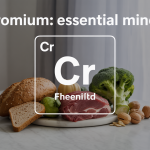The Role of Calcium, Magnesium, and Zinc in Nutritional Intervention
These three powerhouse minerals work together to keep your body running smoothly, yet millions of people don’t get enough of them daily. This guide is designed for healthcare practitioners, nutritionists, and wellness professionals who want to understand how to use targeted mineral supplementation to address deficiencies and improve patient outcomes.
Calcium supports bone health and muscle function. Magnesium regulates over 300 enzyme reactions and helps with sleep and stress management. Zinc boosts immune function and wound healing. When any of these minerals run low, your body sends clear warning signals.
We’ll explore the most common deficiency symptoms and which populations face the highest risk. You’ll also learn evidence-based intervention strategies that actually work, including how to choose the right dietary sources and optimize absorption for maximum benefit. Finally, we’ll cover practical clinical applications so you can create effective treatment plans and track your patients’ progress over time.
Understanding Essential Mineral Functions in Human Health

Calcium’s Critical Role in Bone Density and Muscle Function
Calcium serves as the primary structural component of bones and teeth, accounting for approximately 99% of the body’s total calcium stores. This mineral doesn’t just sit passively in bone tissue – it actively participates in bone remodeling, where old bone tissue gets broken down and replaced with new, stronger material. Peak bone mass typically occurs around age 30, making adequate calcium intake during childhood and young adulthood absolutely crucial for preventing osteoporosis later in life.
Beyond bone health, calcium plays a vital role in muscle contraction and nerve signal transmission. When a nerve stimulates a muscle fiber, calcium ions are released from storage sites within the muscle cell, allowing the contractile proteins actin and myosin to interact and produce movement. This process happens millions of times daily in everything from heartbeats to simple movements like walking or typing.
The body maintains tight control over blood calcium levels through a complex system involving parathyroid hormone, calcitonin, and vitamin D. When dietary calcium is insufficient, the body will actually pull calcium from bones to maintain proper blood levels, highlighting why consistent intake is so important for long-term bone health.
Magnesium’s Impact on Energy Production and Nervous System
Magnesium functions as a cofactor in over 300 enzymatic reactions throughout the body, making it one of the most metabolically active minerals. Its primary role in energy production occurs within cellular mitochondria, where it helps convert food into usable energy (ATP). Without adequate magnesium, cells literally cannot produce energy efficiently, leading to fatigue and decreased physical performance.
The nervous system relies heavily on magnesium for proper function. This mineral helps regulate neurotransmitter release and maintains the electrical gradient across nerve cell membranes. Magnesium deficiency often manifests as muscle cramps, twitches, and even seizures in severe cases, demonstrating its critical role in nerve-muscle communication.
Magnesium also acts as a natural calcium channel blocker, helping muscles relax after contraction. This opposing relationship between calcium and magnesium creates a delicate balance – calcium stimulates muscle contraction while magnesium promotes relaxation. Sleep quality often improves with adequate magnesium intake because this mineral helps activate the parasympathetic nervous system, which signals the body to wind down and prepare for rest.
Blood pressure regulation represents another crucial function of magnesium. The mineral helps blood vessels relax and dilate, reducing peripheral resistance and supporting healthy cardiovascular function.
Zinc’s Essential Functions in Immune Response and Wound Healing
Zinc influences immune function more directly than almost any other mineral. It’s required for the development and activation of T-cells, white blood cells that coordinate immune responses and directly attack infected cells. Zinc deficiency can severely compromise immune function, making individuals more susceptible to infections and slower to recover from illness.
The mineral plays an equally important role in wound healing and tissue repair. Zinc is essential for collagen synthesis, the protein that forms the structural foundation for skin, blood vessels, and connective tissues. During wound healing, zinc helps new cells divide and migrate to repair damaged areas. People with zinc deficiency often experience slow-healing cuts and increased susceptibility to skin infections.
Zinc also supports protein synthesis and DNA production, making it crucial for growth and development. Children and adolescents have particularly high zinc requirements to support rapid growth phases. The mineral contributes to proper taste and smell function as well – zinc deficiency can lead to altered taste perception and reduced appetite.
Male reproductive health depends significantly on zinc, as this mineral is concentrated in high levels in the prostate gland and is essential for testosterone production and sperm development.
Synergistic Effects of Combined Mineral Supplementation
The three minerals work together in complex ways that can either enhance or interfere with each other’s absorption and function. Calcium and magnesium maintain a delicate balance in muscle function – while calcium triggers contraction, magnesium promotes relaxation. The ideal ratio varies depending on individual needs, but many experts suggest a 2:1 or 3:1 calcium to magnesium ratio for optimal function.
Zinc absorption can be significantly impacted by both calcium and magnesium intake. High doses of calcium can interfere with zinc absorption in the small intestine, while moderate amounts of magnesium may actually enhance zinc uptake. This interaction highlights the importance of balanced supplementation rather than mega-dosing individual minerals.
The minerals also work together in bone health beyond just calcium’s structural role. Magnesium activates vitamin D, which improves calcium absorption, while zinc supports the enzymes involved in bone formation. This teamwork approach means that addressing deficiencies in all three minerals simultaneously often produces better outcomes than focusing on just one.
Timing of supplementation matters significantly for these interactions. Taking calcium and zinc together can reduce absorption of both minerals, while spacing them several hours apart allows for better uptake. Magnesium is often best taken in the evening due to its relaxing effects, while zinc is typically better absorbed on an empty stomach, though this can cause nausea in some people.
Identifying Common Deficiency Symptoms and Risk Factors

Early Warning Signs of Calcium Insufficiency
Muscle cramps and spasms often serve as the body’s first alarm bells when calcium levels drop. These uncomfortable contractions typically start in the legs and feet, especially during nighttime hours or after physical activity. The tingling sensation around the mouth and fingertips, known as paresthesia, represents another early indicator that shouldn’t be ignored.
Sleep disturbances frequently accompany calcium deficiency, with many people experiencing restless nights and difficulty falling asleep. Bone and joint pain may develop gradually, often mistaken for aging or overexertion. Dental problems become more apparent as tooth enamel weakens and cavities increase, while brittle nails and hair loss signal the body’s struggle to maintain structural integrity.
Anxiety and mood swings can intensify when calcium stores run low, as this mineral plays a crucial role in neurotransmitter function. Women approaching menopause face heightened risk due to declining estrogen levels, while individuals with lactose intolerance or those following strict vegan diets without proper supplementation often develop deficiencies. Certain medications, including proton pump inhibitors and corticosteroids, can interfere with calcium absorption and increase vulnerability.
Recognizing Magnesium Depletion Indicators
Persistent fatigue that doesn’t improve with rest commonly signals magnesium deficiency. This exhaustion stems from the mineral’s essential role in energy production at the cellular level. Muscle twitches, particularly around the eyelids, and sudden muscle cramps during exercise or at rest provide clear physical evidence of depletion.
Irregular heartbeat or palpitations demand immediate attention, as magnesium maintains normal heart rhythm. Sleep problems intensify when magnesium levels drop, with difficulty falling asleep and frequent nighttime awakenings becoming routine. Headaches and migraines may increase in frequency and severity, while chocolate cravings intensify as the body seeks magnesium-rich foods.
| Risk Factors | Impact Level |
|---|---|
| Chronic stress | High |
| High alcohol consumption | High |
| Diabetes | High |
| Digestive disorders | Moderate |
| Intense physical training | Moderate |
Personality changes, including increased irritability and anxiety, often accompany magnesium deficiency. People with diabetes, alcoholism, or chronic digestive conditions face elevated risk. Athletes and those under chronic stress burn through magnesium reserves quickly, while certain medications like diuretics and antibiotics can deplete stores rapidly.
Detecting Zinc Deficiency Through Physical Symptoms
Slow wound healing represents one of the most recognizable signs of zinc deficiency, as cuts and scrapes take significantly longer to close and repair. White spots on fingernails, though sometimes attributed to trauma, frequently indicate inadequate zinc status when they appear across multiple nails.
Hair loss accelerates when zinc levels drop, with thinning hair and increased shedding becoming noticeable within weeks. Taste and smell changes often develop gradually, with food losing its appeal and flavors becoming muted. Skin problems multiply, including delayed healing of acne, increased susceptibility to infections, and development of dermatitis around the mouth and nose.
Frequent infections signal compromised immune function, as zinc supports white blood cell production and activity. Children with zinc deficiency may experience stunted growth and delayed sexual maturation, while adults often report decreased appetite and unexplained weight loss.
Vegetarians and vegans face higher risk due to plant-based zinc sources having lower bioavailability compared to animal proteins. Individuals with digestive disorders, including Crohn’s disease and celiac disease, struggle with zinc absorption. Pregnant and breastfeeding women require increased zinc intake, making deficiency more likely during these periods. Elderly adults often experience decreased absorption efficiency, compounding the risk when dietary intake becomes inadequate.
Evidence-Based Nutritional Intervention Strategies

Optimal Dosage Recommendations for Therapeutic Benefits
Getting the dosage right makes all the difference when using calcium, magnesium, and zinc for therapeutic purposes. Research shows that calcium supplementation ranges from 500-1200mg daily for most adults, with post-menopausal women often requiring the higher end. The key insight here is that your body can only absorb about 500mg of calcium at one time, so splitting doses throughout the day dramatically improves effectiveness.
Magnesium dosing varies significantly based on the specific condition being addressed. For general deficiency correction, 200-400mg daily works well, but therapeutic applications like migraine prevention may require 400-600mg. The tolerable upper limit sits at 350mg from supplements alone, though this doesn’t include dietary sources.
Zinc supplementation typically ranges from 8-40mg daily, depending on the severity of deficiency and therapeutic goals. Doses above 40mg can interfere with copper absorption and should only be used under professional guidance. For immune support during illness, short-term doses of 15-30mg prove most effective.
| Mineral | General Supplementation | Therapeutic Range | Maximum Safe Dose |
|---|---|---|---|
| Calcium | 500-1000mg daily | 1000-1200mg daily | 2500mg daily |
| Magnesium | 200-400mg daily | 400-600mg daily | 350mg (supplements) |
| Zinc | 8-15mg daily | 15-40mg daily | 40mg daily |
Timing and Absorption Enhancement Techniques
Timing your mineral intake can double or triple absorption rates. Calcium absorption peaks when taken with meals containing some fat, as the acidic environment helps break down calcium compounds. However, avoid taking calcium with high-fiber meals or caffeinated beverages, as these can reduce absorption by up to 40%.
Magnesium shows better absorption when taken on an empty stomach, but this often causes digestive upset. Taking magnesium with a small meal or right before bed works as a practical compromise, plus the mineral’s natural relaxing properties can improve sleep quality.
Zinc absorption works best on an empty stomach, though this can cause nausea in sensitive individuals. Taking zinc with a small amount of protein helps minimize stomach irritation while still maintaining good absorption. Never take zinc with calcium or iron supplements, as these minerals compete for the same absorption pathways.
Split dosing throughout the day prevents mineral competition and reduces the risk of gastrointestinal side effects. Taking calcium in the morning and evening, magnesium before bed, and zinc between meals creates an optimal absorption schedule for most people.
Combining Minerals with Cofactors for Maximum Efficacy
Smart cofactor combinations can amplify mineral effectiveness by 200-300%. Vitamin D3 acts as calcium’s best friend, increasing absorption in the intestines and directing calcium to bones rather than soft tissues. The sweet spot appears to be 1000-2000 IU of vitamin D3 with each 500mg of calcium.
Magnesium pairs beautifully with vitamin B6, especially for women dealing with PMS or hormonal fluctuations. This combination also supports neurotransmitter production and can significantly improve mood and energy levels. Adding 50-100mg of B6 to your magnesium regimen creates noticeable synergy.
Zinc works incredibly well with vitamin C, which helps convert zinc to its most bioavailable form. This combination proves particularly powerful for immune support and wound healing. A 2:1 ratio of vitamin C to zinc (200mg vitamin C with 100mg zinc) shows optimal results in clinical studies.
Copper deserves special attention when supplementing with zinc long-term. Extended zinc supplementation can create copper deficiency, so adding 1-2mg of copper for every 15mg of zinc prevents this imbalance. Many quality zinc supplements now include copper automatically.
Addressing Individual Patient Needs and Health Conditions
Pregnant and breastfeeding women need significantly higher amounts of all three minerals. Calcium requirements jump to 1000-1300mg daily, magnesium to 350-400mg, and zinc to 11-12mg. The developing baby’s needs take priority, often leaving mothers depleted without proper supplementation.
Older adults face unique challenges with mineral absorption. Stomach acid production decreases with age, making calcium citrate a better choice than calcium carbonate. Magnesium glycinate becomes preferred over magnesium oxide due to better absorption and fewer digestive issues.
Athletes and highly active individuals burn through minerals much faster than sedentary people. Zinc losses through sweat can be substantial, especially during intense training periods. Magnesium needs can double during heavy training phases, as the mineral plays crucial roles in energy production and muscle function.
People with digestive conditions like Crohn’s disease or celiac disease often struggle with mineral absorption. Higher doses combined with specific forms (like chelated minerals) can help overcome absorption barriers. Working with a healthcare provider becomes essential for proper dosing in these situations.
Medication interactions require careful consideration. Calcium can interfere with thyroid medications, antibiotics, and bisphosphonates. Zinc affects antibiotic absorption, while magnesium can enhance the effects of blood pressure medications. Timing supplements away from medications by 2-4 hours usually prevents most interactions.
Dietary Sources and Bioavailability Optimization

High-Quality Food Sources for Natural Mineral Intake
Getting calcium, magnesium, and zinc from whole foods gives you the best bang for your buck when it comes to absorption and overall nutrition. Your body recognizes these minerals in their natural matrix much better than isolated forms.
Top Calcium Sources:
- Dark leafy greens like kale, collard greens, and bok choy pack impressive amounts
- Sardines and canned salmon with bones deliver highly absorbable calcium
- Tahini and sesame seeds contain concentrated calcium levels
- Almonds and figs provide calcium along with beneficial compounds
Magnesium-Rich Foods:
- Pumpkin seeds lead the pack with exceptional magnesium content
- Dark chocolate (70% cacao or higher) combines pleasure with nutrition
- Spinach and Swiss chard offer magnesium plus folate
- Avocados deliver healthy fats alongside this crucial mineral
- Black beans and quinoa provide plant-based protein with magnesium
Zinc Powerhouses:
- Oysters contain more zinc per serving than any other food
- Grass-fed beef and lamb offer highly bioavailable zinc
- Pumpkin seeds double as both magnesium and zinc sources
- Hemp seeds and cashews provide plant-based zinc options
The key advantage of food sources lies in their synergistic compounds. Leafy greens contain vitamin K alongside calcium, while nuts provide healthy fats that aid mineral absorption. These natural combinations often work better than taking isolated nutrients.
Supplement Forms with Superior Absorption Rates
When food sources aren’t enough, choosing the right supplement forms makes a massive difference in what your body actually absorbs and uses.
Calcium Supplement Rankings:
| Form | Absorption Rate | Best Timing |
|---|---|---|
| Calcium citrate | 21-27% | Any time |
| Calcium carbonate | 36% (with food) | With meals |
| Calcium malate | 25-30% | Any time |
| Calcium phosphate | 25% | With meals |
Calcium citrate wins for most people because you can take it without food, and it doesn’t cause stomach upset. Calcium carbonate requires stomach acid to break down, making it less reliable for people over 50 or those on acid-blocking medications.
Magnesium’s Best Forms:
- Magnesium glycinate causes the least digestive upset and absorbs well
- Magnesium malate works great for energy and muscle function
- Magnesium citrate has good absorption but can cause loose stools
- Avoid magnesium oxide – it has poor absorption and mainly acts as a laxative
Zinc Absorption Champions:
- Zinc picolinate shows superior bioavailability in studies
- Zinc bisglycinate offers gentle absorption without stomach irritation
- Zinc citrate provides good absorption at moderate cost
- Zinc sulfate, while cheaper, often causes nausea
Chelated forms (bound to amino acids) generally absorb better because they piggyback on your body’s protein absorption pathways. These forms cost more but deliver better results per dollar spent.
Avoiding Nutrient Interactions That Reduce Effectiveness
Timing and combinations can make or break your mineral supplementation efforts. Some nutrients compete for the same absorption pathways, while others enhance uptake.
Problematic Combinations:
- Calcium blocks iron absorption when taken together – separate by 2-3 hours
- High-dose zinc interferes with copper absorption over time
- Calcium and magnesium compete when taken in large amounts simultaneously
- Coffee and tea tannins reduce zinc and iron absorption significantly
- Fiber supplements can bind minerals and reduce their availability
Smart Timing Strategies:
Take calcium and magnesium separately if using high doses (over 500mg each). Your body can only absorb about 500mg of calcium at once anyway, so splitting doses works better.
Zinc absorbs best on an empty stomach, but this often causes nausea. Taking it with a small snack containing protein helps absorption while reducing stomach upset.
Absorption Enhancers:
- Vitamin D dramatically improves calcium absorption and utilization
- Vitamin C boosts both iron and zinc uptake when taken together
- Stomach acid helps break down mineral compounds – avoid taking with antacids
- Protein-rich meals enhance zinc absorption compared to carbohydrate-heavy meals
Medication Interactions to Watch:
Antibiotics (particularly tetracyclines and quinolones) bind to calcium, magnesium, and zinc, reducing both the antibiotic’s effectiveness and mineral absorption. Space these at least 2-4 hours apart.
Proton pump inhibitors and H2 blockers reduce stomach acid, impairing calcium carbonate and zinc absorption. Switch to calcium citrate and take zinc with a protein snack if you use these medications.
The timing game matters more than most people realize. Taking minerals with the wrong foods or supplements can waste money and leave you deficient despite good intentions.
Clinical Applications and Treatment Protocols

Managing Osteoporosis Through Targeted Calcium Therapy
Osteoporosis affects millions worldwide, making targeted calcium intervention a cornerstone of treatment protocols. The standard approach involves prescribing 1,000-1,200 mg of elemental calcium daily, divided into doses of 500 mg or less to maximize absorption. Calcium citrate shows superior bioavailability compared to calcium carbonate, especially for patients with reduced stomach acid production.
Healthcare providers typically combine calcium therapy with vitamin D supplementation (800-1,000 IU daily) to enhance intestinal calcium absorption. Patients with severe osteoporosis may require higher doses under medical supervision, often reaching 1,500 mg daily when dietary intake falls short.
The timing of calcium administration plays a crucial role in treatment success. Taking calcium between meals reduces interference from fiber, iron, and other minerals that can block absorption. For patients on bisphosphonate therapy, calcium supplementation must be spaced at least 30 minutes apart to prevent drug interactions.
Regular monitoring through dual-energy X-ray absorptiometry (DEXA) scans helps track bone density improvements. Blood calcium levels and 24-hour urine calcium tests ensure patients aren’t developing hypercalciuria, which can increase kidney stone risk. Treatment protocols typically show measurable bone density improvements within 12-18 months when combined with weight-bearing exercise and adequate protein intake.
Addressing Cardiovascular Health with Magnesium Intervention
Magnesium deficiency contributes to hypertension, arrhythmias, and increased cardiovascular disease risk. Clinical protocols typically start with 200-400 mg of elemental magnesium daily, gradually increasing to 600 mg based on patient tolerance and serum magnesium levels.
Magnesium glycinate and magnesium taurate offer excellent absorption rates with minimal gastrointestinal side effects. These forms prove particularly beneficial for patients with existing digestive sensitivities. Healthcare providers often recommend splitting doses throughout the day to maintain steady blood levels.
For hypertensive patients, magnesium intervention can reduce systolic blood pressure by 3-5 mmHg and diastolic pressure by 2-3 mmHg. The therapeutic effect typically appears within 4-6 weeks of consistent supplementation. Patients taking diuretics require careful monitoring since these medications can deplete magnesium stores.
Treatment protocols include baseline serum magnesium testing, though normal levels don’t rule out intracellular deficiency. Red blood cell magnesium testing provides better insight into true magnesium status. Cardiac patients on digoxin need dose adjustments when starting magnesium therapy, as adequate magnesium levels can increase digoxin sensitivity.
Regular electrocardiograms help monitor improvements in cardiac rhythm abnormalities. Many patients experience reduced frequency of premature ventricular contractions and improved heart rate variability within 8-12 weeks of treatment.
Supporting Immune Function Through Zinc Supplementation
Zinc deficiency severely compromises immune function, making targeted supplementation essential for certain patient populations. Clinical protocols typically prescribe 8-11 mg daily for maintenance, increasing to 15-30 mg during acute infections or for patients with documented deficiency.
Zinc picolinate and zinc bisglycinate demonstrate superior absorption compared to zinc sulfate, which can cause gastric irritation. Taking zinc supplements on an empty stomach maximizes absorption, though patients with sensitive stomachs may need to take them with food despite reduced bioavailability.
Treatment protocols for wound healing often use higher doses (50-220 mg daily) under medical supervision, particularly for diabetic patients or those with chronic wounds. These therapeutic doses require regular monitoring of copper levels, as zinc can interfere with copper absorption when taken in large amounts.
Immune-compromised patients, including those with HIV, inflammatory bowel disease, or undergoing chemotherapy, benefit from structured zinc supplementation protocols. Treatment typically shows improved immune markers within 2-4 weeks, including increased natural killer cell activity and improved antibody responses.
Laboratory monitoring includes serum zinc levels, though these don’t always reflect tissue status. Taste and smell function often improve within days of starting supplementation in deficient patients, serving as early clinical markers of treatment response.
Integrating Mineral Therapy into Comprehensive Treatment Plans
Successful mineral intervention requires careful coordination with existing medications and treatments. Drug interactions represent a major consideration – calcium can reduce absorption of antibiotics, thyroid medications, and bisphosphonates, while magnesium may enhance the effects of blood pressure medications.
Patient assessment begins with comprehensive dietary analysis, medical history review, and baseline laboratory testing. This approach identifies specific deficiencies and potential absorption issues that could affect treatment outcomes. Gastrointestinal conditions like celiac disease or Crohn’s disease require modified protocols with higher doses and alternative forms.
Treatment plans typically follow a phased approach. The initial phase focuses on correcting severe deficiencies over 3-6 months, followed by maintenance therapy adjusted based on ongoing monitoring. Patients with multiple mineral deficiencies require staggered introduction of supplements to identify individual responses and minimize interactions.
Regular follow-up appointments every 6-8 weeks during the initial treatment phase allow for dose adjustments and monitoring of side effects. Long-term success depends on patient education about dietary sources, proper supplementation timing, and recognizing signs of both deficiency and excess.
Comprehensive treatment plans integrate mineral therapy with lifestyle modifications including dietary changes, exercise programs, and stress management techniques. This holistic approach addresses root causes while providing targeted nutritional support for optimal health outcomes.
Monitoring Progress and Adjusting Intervention Approaches

Laboratory Testing for Mineral Status Assessment
Getting accurate mineral levels requires more than a simple blood test. Serum testing only shows what’s circulating in your bloodstream at that moment, which doesn’t always reflect your body’s true mineral stores. For calcium assessment, serum levels stay remarkably stable even when bone stores are depleted, making ionized calcium and parathyroid hormone (PTH) levels more revealing indicators of calcium status.
Magnesium presents unique testing challenges since less than 1% exists in serum. Red blood cell magnesium provides a better picture of intracellular stores, while the magnesium loading test – where patients receive IV magnesium and urine retention is measured – offers the gold standard for deficiency detection. Many practitioners now use this functional test for patients with persistent symptoms despite normal serum levels.
Zinc assessment benefits from combining serum zinc with functional markers like taste and wound healing assessments. Hair mineral analysis can supplement serum testing for long-term zinc status, though results need careful interpretation alongside clinical symptoms.
Testing frequency depends on severity and intervention type. Initial deficiencies warrant retesting every 4-6 weeks, while maintenance protocols may only require quarterly monitoring. Always test during consistent conditions – same time of day, fasting status, and supplement timing – to ensure reliable comparisons.
Tracking Clinical Improvements and Patient Response
Patient symptoms often improve before laboratory values normalize, making systematic symptom tracking essential for intervention success. Create detailed baseline assessments covering sleep quality, energy levels, muscle cramps, mood changes, and cognitive function. Weekly check-ins during the first month help identify early improvements and potential side effects.
Calcium interventions typically show bone health improvements within 3-6 months, while muscle cramps and sleep disturbances may resolve within weeks. Blood pressure changes can occur within the first month of adequate calcium intake, particularly in previously deficient individuals.
Magnesium response patterns vary significantly. Muscle cramps and tension often resolve within days, while chronic fatigue and mood improvements may take several weeks. Sleep quality frequently improves within the first week, serving as an early positive indicator. Migraine frequency reduction typically becomes apparent after 6-8 weeks of consistent supplementation.
Zinc interventions show rapid wound healing improvements within 2-3 weeks, while immune function enhancement becomes noticeable after 4-6 weeks. Taste and smell recovery may take 2-3 months of adequate zinc status restoration.
Document both positive responses and any adverse effects. Digestive upset, particularly with zinc and magnesium, may indicate dosing adjustments are needed. Some patients experience initial detoxification symptoms as mineral balance improves, requiring temporary dose modifications.
Modifying Protocols Based on Individual Outcomes
Successful mineral intervention requires flexibility and willingness to adjust approaches based on patient response. Standard protocols serve as starting points, but individual variations in absorption, metabolism, and clinical response demand personalized modifications.
Poor absorption responses may require switching delivery methods. Patients struggling with oral magnesium absorption often benefit from transdermal applications or Epsom salt baths. Calcium citrate may work better than carbonate for individuals with low stomach acid. Zinc picolinate or bisglycinate forms often improve tolerance compared to zinc sulfate.
Dosing adjustments should follow patient response patterns rather than rigid schedules. Some individuals require higher initial doses followed by maintenance reductions, while others need gradual dose increases to avoid digestive upset. Split dosing throughout the day often improves absorption and reduces side effects, particularly for magnesium and zinc.
Timing modifications can significantly impact outcomes. Taking calcium with meals improves absorption but may interfere with iron uptake. Magnesium before bedtime enhances sleep benefits, while morning doses may cause drowsiness in sensitive individuals. Zinc on an empty stomach maximizes absorption but may cause nausea in some patients.
Co-factor additions often unlock stubborn cases. Vitamin D enhances calcium absorption, while B6 improves magnesium utilization. Copper balance becomes important during long-term zinc supplementation to prevent deficiency.
Regular protocol reviews every 8-12 weeks allow for systematic adjustments based on accumulated data. Successful interventions may require dose reductions to prevent oversupplementation, while persistent symptoms might indicate the need for additional testing or alternative approaches.

Calcium, magnesium, and zinc work together as a powerhouse trio for your health, supporting everything from strong bones to a robust immune system. When your body doesn’t get enough of these minerals, you might experience fatigue, muscle cramps, poor wound healing, or increased susceptibility to illness. The good news is that targeted nutritional interventions can make a real difference – whether through carefully planned meals rich in leafy greens, nuts, seeds, and lean proteins, or through strategic supplementation when dietary sources aren’t enough.
The key to success lies in understanding that these minerals don’t work in isolation. They need each other and other nutrients to be properly absorbed and used by your body. If you’re experiencing unexplained symptoms or have risk factors for deficiency, consider working with a healthcare provider to assess your mineral status and develop a personalized intervention plan. Regular monitoring helps ensure you’re on the right track and allows for adjustments as your needs change over time.














